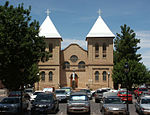Mesilla Plaza
Geography of Doña Ana County, New MexicoHistoric American Buildings Survey in New MexicoHistoric American Landscapes Survey in New MexicoHistoric districts on the National Register of Historic Places in New MexicoNRHP infobox with nocat ... and 3 more
National Historic Landmarks in New MexicoNational Register of Historic Places in Doña Ana County, New MexicoUse mdy dates from August 2023

Mesilla Plaza is the central plaza in the small town of Mesilla in far southern New Mexico. The plaza and a number of its surrounding buildings are a National Historic Landmark District, significant for its role in the transfers of power that brought first the original New Mexico Territory and later the Gadsden Purchase into United States control. The most notable building facing the plaza is the Basilica of San Albino, which has been on the plaza since its establishment in 1851. The plaza was declared a National Historic Landmark in 1961.
Excerpt from the Wikipedia article Mesilla Plaza (License: CC BY-SA 3.0, Authors, Images).Mesilla Plaza
Calle Principal,
Geographical coordinates (GPS) Address Phone number Nearby Places Show on map
Geographical coordinates (GPS)
| Latitude | Longitude |
|---|---|
| N 32.274310833333 ° | E -106.795462 ° |
Address
Mesilla Book Center
Calle Principal 2360
88046
New Mexico, United States
Open on Google Maps





